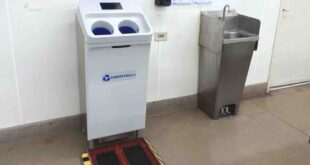Huge advancements in technology in recent times have provided unprecedented development in nearly all areas of life. One of the demographics that’s often left behind or uninterested by technology (compared with other generations) is the elderly. Making the lives of the elderly better or easier is not an area that has necessarily been heavily researched or invested in. Matthew Margetts provides insight into how new smart technology can greatly improve the lives of our elderly population
The 4th Industrial Revolution has improved the way many do business by consolidating and streamlining operations. We’re now starting to understand how the Internet of Things (IoT) is hugely beneficial for our home and work lives as well. But more than just a helpful addition to daily life, smart technology can drastically improve environments for the elderly and other vulnerable groups by improving safety.
So, what are some of the emerging technologies? There has been a vast development in smart technology innovation over the past few years, so much so that it’s been difficult to keep up with all the terminology.
Digital twin technology. Using sensors throughout the home, digital twins can collect real-time data about a physical item and then create a virtual duplicate as a way to test scenarios for future improvement. For building managers, digital twins can help identify and act on potential safety hazards for elderly and vulnerable citizens.
Cybersecurity. The IoT has taken everything online, which means that there is a vast amount of personal data now available. In-built cybersecurity will protect this valuable information from outside attacks, which is especially important for the elderly community sector as they’re often targeted by ruthless fraudsters.
Data monitoring software. The gathering of home-based data through sensor technology is great, but this needs to be analysed and translated into something you can understand. Data monitoring software will do just this, while providing you with an easy-to-use dashboard for real-time access.
How can technology improve safety for vulnerable citizens?
By incorporating smart technology in the care home or elderly care environment, you’re able to establish a smart home setup that maximises safety and security for the most vulnerable citizens. Here’s a look at some of the ways this can be achieved.
Air quality monitoring. Where homes have a gas supply, there is always the risk of leaks and harmful carbon dioxide putting lives at risk. Smart technology provides air quality monitoring to detect carbon dioxide levels and even pollution levels in city-based homes.
Temperature and humidity control. The climate crisis leads to dangerously high summertime temperatures, with humidity levels creating additional health hazards. Elderly citizens have less temperature regulation control, placing them at a much higher risk of heatstroke and dehydration. Smart technology that includes sensors and thermostats will allow you to monitor remotely the temperature and humidity levels and adjust the internal environment accordingly. Some systems will even alert you when dangerous levels are detected.
Fire safety. While fire is a significant risk for anyone in the home, elderly and vulnerable citizens are particularly high-risk because of the impact of medication or immobility. Smart technology can include fire sensor devices that improve your compliance with local regulations while better-protecting residents. These devices can monitor the fire doors, smoke detectors, and fire extinguishers to alert you when maintenance and replacements are needed.
Security solutions. One of the biggest assets of smart technology for protecting elderly and vulnerable citizens is its security features. A comprehensive security network will give you remote management of all doors, windows, and other home vulnerabilities, as well as real-time access to the system.
Health monitors. There are many ways that smart technology is improving access to health services, particularly for those who are immobile. Biomedical monitoring devices have sensors that provide 24-hour data on a person’s health. Real-time alerts can be sent if a person is struggling in any way, with telehealth services mitigating any need for patient transport. Doctors and nurses can attend to a patient from a distance relying on the data being uploaded. You can also programme the smart home device to notify senior or vulnerable citizens when it’s time to take medication.
Home automation. Everything from television sets and kettles to lighting can be automated, making everyday tasks that much easier for elderly citizens. Automated lighting, in particular, is a major safety feature that decreases the likelihood of falls or injuries. These can all be voice-activated for ease of use.
What are the other benefits of smart technologies?
Beyond the direct benefits of such technology for elderly and vulnerable citizens, these technologies are also beneficial for building managers. Some of these include:
Energy management. Digital twins of the building’s energy profile can be created to provide a comprehensive overview of where energy is being wasted, and how the building can be optimised. This not only puts you in line with green energy regulations, but it will also save you a lot of money over time.
Building management. Beyond energy use, digital twins can measure changes in aspects like temperature, movement, air quality, and more so that you’re constantly updated on the state of your building. Where maintenance and repairs are needed, you can attend to them before they become a costly problem later on.
Matthew Margetts is a Director at Smarter Technologies.
 Engineer News Network The ultimate online news and information resource for today’s engineer
Engineer News Network The ultimate online news and information resource for today’s engineer



